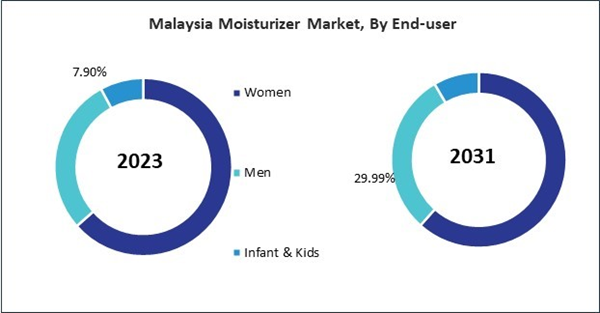It typically contains a blend of water and oil-based ingredients, including emollients like glycerin, which help to lock in moisture, and humectants such as hyaluronic acid, which attract water to the skin’s surface. Thus, the China market would utilize56.07 million units (50 ML) of Moisturizer by 2031.
The China market dominated the Asia Pacific Moisturizer Market by Country in 2023, and would continue to be a dominant market till 2031; thereby, achieving a market value of$1.63 billion by 2031. The Japan market is registering a CAGR of 4.8% during (2024 - 2031). Additionally, The India market would exhibit a CAGR of 6.1% during (2024 - 2031).
The moisturizer market has seen remarkable growth over the past few decades, evolving from a basic necessity in skincare to a sophisticated, multi-faceted industry. Once dominated by a handful of brands offering simple hydrating solutions.
Additionally, evolution reflects broader trends in consumer behaviour, scientific advancements in skincare, and the influence of cultural shifts and economic factors.
The expansion of the middle class and the growth in disposable incomes in the region have contributed to an increased emphasis on personal hygiene and skincare. According to the Asian Development Bank, the middle class in Asia is expected to reach 3.5 billion people by 2030, up from 1.4 billion in 2010. The demographic transition has generated substantial demand for skincare merchandise, such as moisturizers.
Based on Type, the market is segmented into Face Moisturizer, and Body Moisturizer. Based on Form, the market is segmented into Cream, Lotion, and Gel. Based on End-user, the market is segmented into Women, Men, and Infant & Kids. Based on countries, the market is segmented into China, Japan, India, South Korea, Australia, Malaysia, and Rest of Asia Pacific.
List of Key Companies Profiled
- L'Oreal S.A.
- Unilever PLC
- The Procter & Gamble Company
- Johnson & Johnson
- Kao Corporation
- The Estee Lauder Companies, Inc.
- Shiseido Company Limited
- Beiersdorf AG
- Henkel AG & Company, KGaA
- Coty, Inc.
Market Report Segmentation
By Type (Volume, Thousand Units, USD Billion, 2020-2031)
- Face Moisturizer
- Body Moisturizer
By Form (Volume, Thousand Units, USD Billion, 2020-2031)
- Cream
- Lotion
- Gel
By End-user (Volume, Thousand Units, USD Billion, 2020-2031)
- Women
- Men
- Infant & Kids
By Country (Volume, Thousand Units, USD Billion, 2020-2031)
- China
- Japan
- India
- South Korea
- Australia
- Malaysia
- Rest of Asia Pacific
Table of Contents
Companies Mentioned
- L'Oreal S.A.
- Unilever PLC
- The Procter & Gamble Company
- Johnson & Johnson
- Kao Corporation
- The Estee Lauder Companies, Inc.
- Shiseido Company Limited
- Beiersdorf AG
- Henkel AG & Company, KGaA
- Coty, Inc.
Methodology

LOADING...









